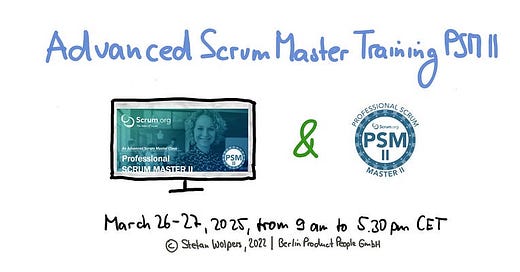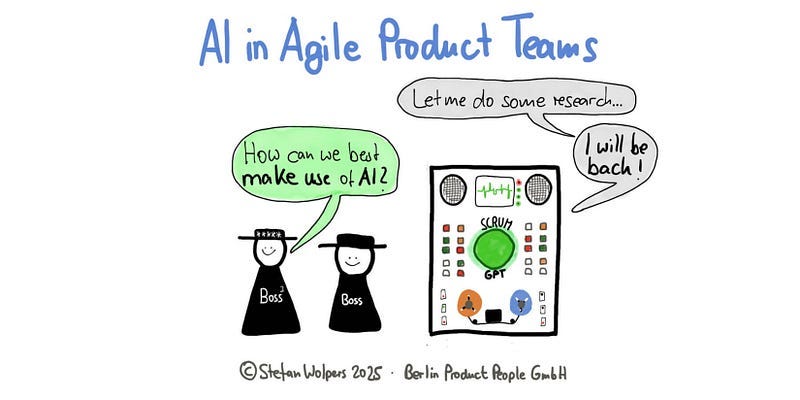Food for Agile Thought #483: Leadership Blindspots, Tyranny of Incrementalism, Who Does Strategy?
Also: Product Teams 4 Success; Rank vs. Prio; Haier Self-Management
Hello everyone!
Welcome to the 483rd edition of the Food for Agile Thought newsletter, shared with 42,689 peers.
This week, Luona Lin and Kim Parker reveal U.S. workers’ anxiety around AI’s workplace impacts, while Lennart Meincke, Ethan Mollick, Lilach Mollick, and Dan Shapiro stress context-dependent complexities in prompt engineering. Charlie Guo sees AI hallucinations becoming manageable, Claire Lew identifies overlooked leadership blindspots, Joost Minnaar showcases Haier’s entrepreneurial employee model, and Arjun Shah champions ambitious “maximum thinking” over incrementalism.
Next, Will Larson explains how anyone, including engineers, can meaningfully shape organizational strategy through practical influence, while Ian Vanagas shares PostHog’s lessons on team autonomy, rapid iteration, and customer-driven development. Scott Sehlhorst highlights the power of clear problem statements, and Roman Pichler emphasizes intentional team design as key to sustained product success.
Lastly, Dan Shipper highlights Michael Taylor’s AI tool, Rally, which transforms customer research through risk-free audience simulations, while Aakash Gupta and Colin Matthews showcase rapid, code-free AI prototyping with Bolt, Lovable, v0, Replit, and Cursor. Johanna Rothman clarifies ranking versus prioritization for limiting WIP, and Jeff Gothelf outlines effective OKR retrospectives emphasizing preparation and evidence-based adjustments.
🛑 Becoming obsolete is a choice, not inevitable!
👉 Don’t Miss Out—Join the Second Cohort: AI for Agile Practitioners: Pilot Cohort #2, May 14 to June 11, 2025, at € 199!
Did you miss the previous Food for Agile Thought issue 482?
🏆 The Tip of the Week
(via Pew Research Center): U.S. Workers Are More Worried Than Hopeful About Future AI Use in the Workplace
Luona Lin and Kim Parker highlight Pew Research’s recent survey, which revealed that U.S. workers feel more anxiety than optimism about AI in workplaces. They believe it might reduce job opportunities and speed tasks without significantly improving quality.
Source: Pew Research Center: U.S. Workers Are More Worried Than Hopeful About Future AI Use in the Workplace
🧠 Artificial Intelligence
Ethan Mollick (via SSRN): Prompting Science Report 1: Prompt Engineering is Complicated and Contingent
Lennart Meincke, Ethan Mollick, Lilach Mollick, and Dan Shapiro emphasize that AI benchmarking and prompt engineering lack universal standards, highlighting that effective prompting depends heavily on context, with politeness or constraints sometimes improving — and sometimes harming — performance.
Source: SSRN: Prompting Science Report 1: Prompt Engineering is Complicated and Contingent
Author: Ethan Mollick
Charlie Guo: Hallucinations Are Fine, Actually
Charlie Guo argues AI hallucinations, previously seen as critical flaws, are becoming manageable as models improve, specialized tools mitigate errors, and users adapt to collaborative augmentation rather than full automation.
Source: Hallucinations Are Fine, Actually
Author: Charlie Guo
📺 Dan Shipper and Mike Taylor (via Every): He Built an AI Audience Simulator. It’s the Future of Customer Research.
Dan Shipper explores Michael Taylor’s creation, Rally, an innovative AI tool enabling realistic audience simulations for rapid, risk-free customer feedback, transforming traditional approaches to market research and decision-making.
Source: Every: 📺 He Built an AI Audience Simulator. It’s the Future of Customer Research.
Authors: Dan Shipper and Mike Taylor
➿ Agile & Leadership Blindspots
Claire Lew: The 10 Biggest Leadership Blindspots Based on 10 Years of Research
Claire Lew highlights the ten most critical leadership blindspots uncovered through extensive research, emphasizing that leaders often unknowingly create conditions they seek to avoid, encouraging self-reflection to genuinely improve team trust and performance.
Source: The 10 Biggest Leadership Blindspots Based on 10 Years of Research
Author: Claire Lew
Joost Minnaar (via Corporate Rebels): Haier’s Radical Experiment: What If Every Employee Was an Entrepreneur?
Joost Minnaar explores how Haier transforms employees into entrepreneurs by granting them autonomy, profit-sharing opportunities, and freedom to fail — creating a culture that rewards innovation, ownership, resilience, and continual experimentation.
Source: Corporate Rebels: Haier’s Radical Experiment: What If Every Employee Was an Entrepreneur?
Author: Joost Minnaar
Arjun Shah (via Medium): Thinking in Maximums. Escaping the tyranny of incrementalism
Arjun Shah argues against incremental “MVP culture,” advocating instead for “maximum thinking,” emphasizing ambitious visions, sustained commitment, and bold innovation as essential to achieving transformative, industry-defining breakthroughs.
Source: Medium: Thinking in Maximums. Escaping the tyranny of incrementalism
Author: Arjun Shah
🖥 🇬🇧 Advanced Professional Scrum Master Training w/ PSM II Certificate — March 26–27, 2025
Discover Scrum’s four success principles in this official Scrum.org Advanced Scrum Master training class, which includes the industry-recognized PSM II certification. The PSM II training class is designed as a live virtual class and will be in English.
Enjoy the benefits of a live virtual immersive class with like-minded agile peers from 09:00–17:30 CET.
Learn more: 🖥 🇬🇧 Advanced Professional Scrum Master Training w/ PSM II Certificate — March 26–27, 2025.
Customer Voice: “Dear Stefan, Thanks a lot for two intense and mindblowing days. Your way of teaching suites me perfectly. I must admit that all the positive feedback you have gotten is spot on! I would any time a day recommand your class to a Scrum Master who wants to add a whole new level to his/her scrum game. To all of you reading this. You have to experience Stefans class to understand how good it is.” (Source.)
🎯 Product
Will Larson: Who gets to do strategy?
Will Larson argues anyone in an organization can influence strategy, regardless of role, emphasizing practical approaches for engineers and executives to navigate constraints and political sensitivities to shape organizational decisions meaningfully.
Source: Who gets to do strategy?
Author: Will Larson
Ian Vanagas (via PostHog): 50 things we’ve learned about building successful products
Ian Vanagas distills lessons from PostHog, emphasizing small-team autonomy, clear ownership, rapid shipping with real user feedback, engineer-driven product decisions, meaningful metrics, targeted experimentation, and genuine excitement about the product.
Source: PostHog: 50 things we’ve learned about building successful products
Author: Ian Vanagas
Roman Pichler: Setting up Product Teams for Success
Roman Pichler explains that successful product teams rely heavily on intentional team design — comprising clear goals, empowerment, and organizational support — which significantly impacts performance, outweighing even effective launches or coaching interventions.
Source: Setting up Product Teams for Success
Author: Roman Pichler
Scott Sehlhorst: Problems in the Solution
Scott Sehlhorst emphasizes that even when product managers don’t set strategic direction, clearly defining problem statements within mandated initiatives provides essential clarity, helps avoid premature solutions, and ensures meaningful outcomes.
Source: Problems in the Solution
Author: Scott Sehlhorst
📯 AI in Agile Product Teams: Insights from Deep Research and What It Means for Your Practice
I have been interested in how artificial intelligence as an emerging technology may shape our work since the advent of ChatGPT; see my various articles on the topic. As you may imagine, when OpenAI’s Deep Research became available to me last week, I had to test-drive it.
I asked it to investigate how AI-driven approaches enable agile product teams to gain deeper customer insights and deliver more innovative solutions. The results were enlightening, and I’m excited to share both my experience with this research approach and the key insights that emerged.
Learn more: AI in Agile Product Teams: Insights from Deep Research and What It Means for Your Practice.
🛠 Concepts, Tools & Measuring
📺 Aakash Gupta: Tutorial of Top 5 AI Prototyping Tools: Bolt, Lovable, v0, Replit, and Cursor
Aakash Gupta and Colin Matthews provide a live, hands-on tutorial demonstrating five leading AI prototyping tools — Bolt, Lovable, v0, Replit, and Cursor — to rapidly build and refine product features without writing code.
Source: 📺 Tutorial of Top 5 AI Prototyping Tools: Bolt, Lovable, v0, Replit, and Cursor
Author: Aakash Gupta
Johanna Rothman: How to Tell the Difference Between Rank-Order and Prioritization
Johanna Rothman clarifies the critical difference between ranking and prioritization, arguing that true ranking — selecting exactly one item per position — is essential to limit WIP, boost throughput, and ensure meaningful team autonomy.
Source: How to Tell the Difference Between Rank-Order and Prioritization
Author: Johanna Rothman
Jeff Gothelf: How to Run an OKR Retrospective: A Step-by-Step Guide
Jeff Gothelf provides a clear, practical guide for running quarterly OKR retrospectives, emphasizing preparation, visual clarity, evidence-driven course corrections, and keeping discussions future-focused to maximize meeting effectiveness and stakeholder alignment.
Source: How to Run an OKR Retrospective: A Step-by-Step Guide
Author: Jeff Gothelf
📅 Training Classes, Meetups & Events 2024
Upcoming classes and events:
🖥 💯 🇩🇪 March 11–12 — Live Virtual Class: Professional Scrum Product Owner Training (PSPO I; German)
🖥 💯 🇬🇧 March 26–27 — Live Virtual Class: Professional Scrum Master Advanced Training (PSM II; English)
🖥 💯 🇩🇪 April 10 — Live Virtual Class: Professional Product Discovery & Validation Training (PPDV; German)
🖥 🇬🇧 April 24 — Live Virtual Class: Professional Scrum Facilitation Skills Class (PSFS; English)
🖥 🇩🇪 April 29–30 — Live Virtual Class: Professional Scrum Product Owner Training (PSPO I; German)
🖥 💯 🇬🇧 May 14-June 11 — Live Virtual Cohort: AI for Agile Practitioners (English)
🖥 🇩🇪 June 3–4 — Live Virtual Class: Professional Scrum Product Owner Training (PSPO I; German)
👉 See all upcoming classes here
📺 Join 6,000-plus Agile Peers on Youtube
Now available on the Age-of-Product YouTube channel:
Hands-on Agile 66: Escape the Feature Frenzy, Build to Sell with Sandrine Olivencia
Hands-on Agile 62: From Backlog Manager to Product Manager w/ David Pereira
Hands-on Agile 61: Toyota Kata Coaching for Agile Teams & Transformations with Fortune Buchholtz
Hands-on Agile 59: Tackling Fake Agility w/ Johanna Rothman
Hands-on Agile 57: Humble Planning w/ Maarten Dalmijn
Hands-on Agile Extra: How Elon Musk Would Run YOUR Business mit Joe Justice
🎓 Do You Want to Read more like this?
Also:
📅 Join 6,000-plus peers of the Hands-on Agile Meetup group
🐦 Follow me on Twitter and subscribe to my blog, Age of Product
💬 Alternatively, join 20,000-plus peers of the Slack team “Hands-on Agile” for free.









I just wanted to say - glad you are not highlighting the "lemon of the week" anymore - I'm sure there are those who are just doing it to bait clicks or being obnoxiously aggressive; but for others whose takes we don't agree with or are misinformed, perhaps we can use Ron Jeffries' "one dumb idea" approach to help us look at it as an opportunity to educate or perhaps fork the conversation in ways we had not intended. Throughout my learning journey I'll admit to some lemons in my day, but now I'm drinking sweet lemonade. ;)